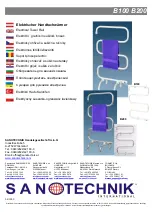
Instruction manual BFM
15
gis
2.5
Safety of the instal-
lation
In addition to the appliance's standard built-in safety monitoring, the appliance
must also be protected by an expansion vessel, expansion valve, pressure
reducing valve, non-return valve and a T&P valve.
The use of an expansion vessel, expansion valve and/or pressure reducing
valve depends on the type of installation: unvented or vented.
2.5.1
Unvented installation
With an unvented installation, an expansion valve valve and expansion vessel
prevent the buildup of excessive pressure in the tank. This prevents damage
being caused to the enamelled coating (in the appliance) or to the tank. A non-
return valve prevents excessive pressure buildup in the water supply system.
This valve also prevents water from flowing backwards from the tank into the
cold water supply system. The pressure reducing valve protects the installation
against an excessively high water supply pressure (> 8 bar). These components
are fitted to the cold water pipe
(3.6 "Water connections, Vented")
.
2.5.2
Vented installation
With a vented installation, excess pressure is taken up by the open cold water
head tank. The height of the head tank determines the working pressure in the
water heater, which may not exceed 8 bar. The installation must also be fitted
with a vent pipe from the hot water pipe, that opens into the cold water tank.
Ideally, the vent pipe should discharge into a separate tundish/drain or
otherwise to the open cold water head tank. The water heater should also be
fitted on the hot water side with a stop valve
(3.7.3 "Hot water side")
.
2.5.3
T&P valve
A T&P valve is only mandatory in an unvented installation. However, A.O. Smith
also recommends the use of a T&P valve in vented installations.
A T&P (Temperature and Pressure Relief) valve monitors the pressure in the
tank and the water temperature at the top of the tank. If the pressure in the tank
becomes excessive (> 10 bar) or the water temperature is too high (> 97°C), the
valve will open. The hot water can now flow out of the tank. Because the
appliance is under water supply pressure, cold water will automatically flow into
the tank. The valve remains open until the unsafe situation has been rectified.
The appliance is fitted standard with a connecting point for a T&P
valve
(3.7.3 "Hot water side")
.
Summary of Contents for BFM - 100
Page 1: ......
Page 2: ......
Page 4: ...4 Instruction manual BFM gis ...
Page 10: ...Introduction 10 Instruction manual BFM 1 gis ...
Page 16: ...Working principle of the appliance 16 Instruction manual BFM 2 gis ...
Page 42: ...Conversion to a different gas category 42 Instruction manual BFM 4 is ...
Page 48: ...Draining 48 Instruction manual BFM 6 gis ...
Page 52: ...Status of the appliance 52 Instruction manual BFM 8 gis ...
Page 54: ...Starting and running 54 Instruction manual BFM 9 gis ...
Page 56: ...Shutting down 56 Instruction manual BFM 10 gis ...
Page 62: ...is Instruction manual BFM 62 ...
Page 72: ...Electrical diagram 72 Instruction manual BFM 14 is ...
Page 74: ...0306 723 4 0 UK Index Instruction manual BFM ...
















































